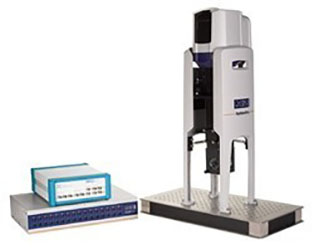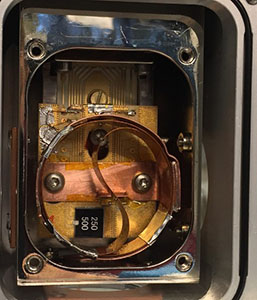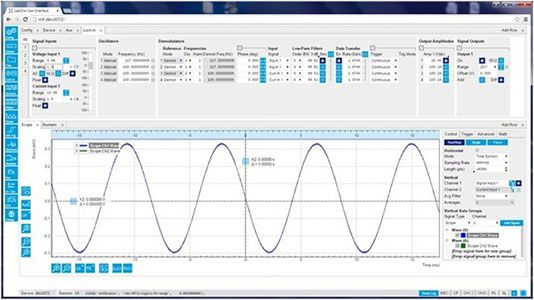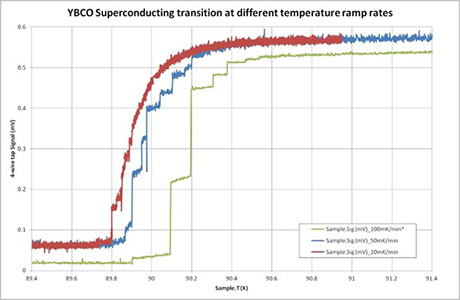Resources
 Part of the Oxford Instruments Group
Part of the Oxford Instruments Group
Expand
Collapse
 Part of the Oxford Instruments Group
Part of the Oxford Instruments Group
This application note describes an experiment to measure the resistance of High Temperature Superconductor (HTS) tape and determine the superconducting transition temperature, Tc. The measurements were carried out using OptistatDry cryogenic system with the demountable sample puck option, combined with a Zurich Instruments’ MFLI (Medium Frequency Lock-in) amplifier. The experiment demonstrates the adaptability and controllability of the cryogenic platform as well as the ability of the MFLI to resolve small signals with excellent background noise rejection.

Figure 1. SampleProtect measurement system set-up including OptistatDry cryostat, MFLI Lock-in Amplifier and an ESD break-out box - used for this application.
The OptistatDry was set-up with the MFLI and a ESD break-out box (see Figure 1). SuperPower 2G YBCO HTS tape, from Furukawa Electric was used as the sample. A 500 mm length of this tape was coiled in a non-inductive loop and mounted to an OptistatDry sample puck using a custom-made copper bracket (see Figure 2). The 12 mm wide tape had voltage taps applied 15 mm from each end, giving 470 mm between the voltage taps. Current supply terminals were added at each end of the tape to provide an excitation current through the tape. The sample puck included a CX 1050 SD CernoxTM sensor and a 50 Ω 25 W surface-mount heater. The room-temperature end-to-end resistance of the current loop (HTS sample plus wiring loom plus cabling) was 149.2 Ω measured at the break-out box terminals. The OptistatDry heat exchanger also has a CX 1050 SD CernoxTM sensor and a heater. The system, under MercuryiTC control, allows for simultaneous sweeps of the heat exchanger and sample puck temperatures at precise user selected rates. To resolve the superconducting transition in the YBCO, temperature sweeps were conducted at 0.1 K/min, 0.05 K/min and 0.01 K/min over the transition region. The MFLI was used, both as a low-distortion function generator and as a Lock-in Amplifier to recover the small, demodulated response. Its Scope capability also allowed monitoring of the input signal in real time.

Figure 2. YBCO coil (marked with the arrow) mounted on the sample puck.

Figure 3. The MFLI LabOne interface from Zurich Instruments. The scope chart shows the signal across the YBCO at 100 K with a ± 20 V, 117 Hz excitation, peak-to-peak voltage of 0.62 mV.
| Mercury Settings | MFLI Settings (See Figure 3) | |
| Three temperature sensors: | Excitation: | |
| (1st stage, heat exchanger, sample puck) | Profile | Sinusoidal |
| Frequency | 117 Hz | |
| Two Control Loops: | Amplitude | ± 20 V |
| Sample puck sensor heater : PID 100, 0.1, 0 | Configuration | |
| Heat exchanger sensor/heater: PID 100, 0.2, 0 | Differential | |
| Measurement: | ||
| Temperature Sweeps: | Mode | |
| 86 K to 92 K at 0.1K/min | Scope wave / LIA | |
| 89 K to 92 K at 0.05 K/min and 0.01 K/min | Configuration | |
| Differential | ||
| Input Range | 3 mV | |
| Scaling Factor | 1 | |
| Sample Rate | 496 kHz | |
| Transfer Rate | 1674 Sa/s | |
| Data Buffer | 16384 samples | |
| PC Read Rate | 1 Sa/s | |

Figure 4. Tc data showing the propagation of the superconducting state through the YBCO material as the coiled tape sample is warmed at different heating rates. *Note: a smaller excitation voltage was applied for the 100 mK/min.
The puck loading system of the OptistatDry is optimised for small quantum device samples but can easily be adapted for larger items. The data in Figure 4 shows the superconducting transition (Tc) occurs over a temperature range because there is a temperature gradient across the relatively large coil of YBCO, which is approximately 40 mm in diameter. The faster temperature sweeps expose the granular nature of the YBCO material. The domains appear to change state in avalanche groups as the temperature of the YBCO loop rises. The transition can be controlled and resolved more uniformly using a slower temperature sweep, which is easily achieved with the precision and accuracy of the MercuryiTC controller.
A 4-wire resistance measurement technique is not the ideal method for determining the Tc of a material. This measurement is an exercise to demonstrate the adaptability and measurement qualities of the OptistatDry system and the MFLI. The small signals which needed to be resolved in making these measurements would have been challenging for a DC resistivity technique. Using an AC-technique with the MFLI lock-in amplifier, makes these measurements achievable. Without taking excessive care with cabling, it was still possible to reach a noise base of around 12 µV. The measurement frequency of 117 Hz was chosen to avoid higher frequency crosstalk from the cabling, as well as significant phase shift between the excitation and measurement signals and to minimise higher harmonic components. With the multi-demodulator MFLI input, harmonic distortion can be measured simultaneously (not shown here).
The ESD break-out box (see Figure 1) provides electrostatic discharge protection, that also includes a precision in-line 5 mΩ resistor. Due to this, it was possible to use the same measurement technique to establish that the excitation current flowing through the YBCO sample was 104 mA, when the sample was at a temperature of 91 K. It showed a normal state resistance value of 5.48 mΩ for the YBCO tape and backing material. From the SuperPower datasheet for this tape batch, the actual width is 12.04 mm with a thickness of 216 microns. From this measurement of the resistance of the 470 mm length, we can estimate the normal state resistivity of the tape (YBCO plus backing material) to be 3 x 10-8 Ωm.
The superconducting transition of YBCO could be clearly demonstrated at various heating rates. With such a cryogenic and instrumentation configuration, many differential measurements of various physical properties (resistivity, current, capacitance, etc.) can be performed over a wide range of temperatures and driving modulation. Phase information and multi- demodulator configuration, at higher harmonics or multiple frequencies can be acquired at the same time without any hardware modification, allowing more flexibility in the design of such low-temperature experiments.
The OptistatDry provides a temperature-controlled sample in vacuum measurement environment within a Cryofree cryostat. The OptistatDry comprises a range of compact cryostats with optical access cooled by a closed cycle refrigerator. The system is capable of cooling samples to helium temperatures without the need for liquid cryogens. This provides significant benefits in terms of ease of use and running costs. The system enables optical and electrical measurements to be carried out on your samples, as shown in this application note.
Zurich Instruments' MFLI uses the latest hardware and software technologies to bring the benefits of high-performance digital signal processing to lock-in amplifiers at medium and low frequencies. The MFLI features a differential voltage input as well as a current input, a dual-phase demodulator, and a high-quality signal generator, covering a frequency range DC to 500 kHz or DC to 5 MHz. With its superior performance and outstanding toolset, the MFLI defines a new standard for lock-in amplifiers.
Date: August 2022
Author: Simon Mitchinson (Oxford Instruments)
Category: Application Note
